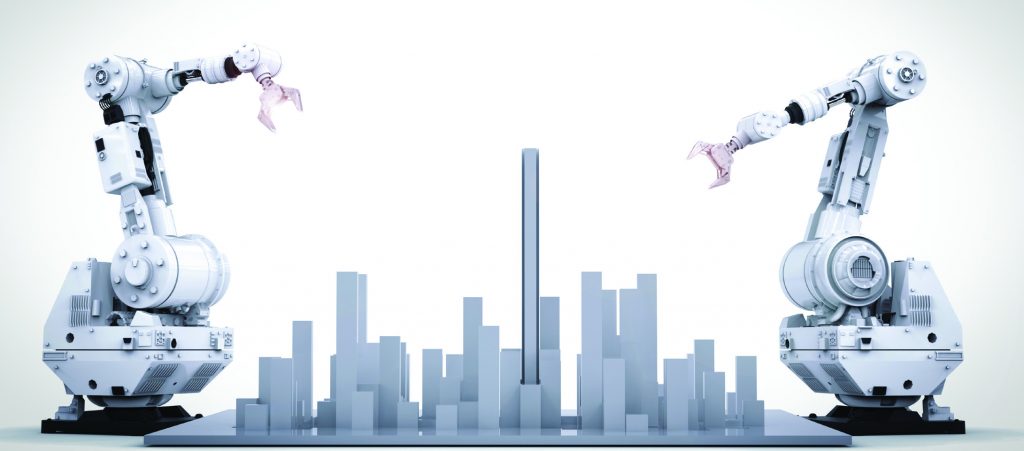Huge tower blocks built in weeks under one roof, automated bridge building behemoths and bricklaying robots. No, it is not science fiction. These are all real solutions in doing business here and now. And soon there will be more. So what are the big trends in construction in Europe, the United States (US) and Asia, and how can we turn them from opportunities into business benefits?
According to the 11th Malaysia Plan, the construction sector is primed to grow by 10.3 per cent this year. The Malaysian construction sector will continue to benefit from the implementation of mega infrastructure projects and the rapid development of townships with the local economy growing by at least four per cent, as per a study by the Construction Industry Development Board (CIDB) Malaysia. “These predictions clearly indicate that construction companies need to scale up their operations to support the market growth,” attested Sridharan Arumugam, Vice President for IFS Southeast Asia. “Currently, many construction companies are stuck in the old-fashioned way of operating with spreadsheets and outdated systems. They need to act now to modernise operations with enterprise software that integrates all core business processes to run in an agile, timely and efficient manner to remain competitive.”
OPPORTUNITY #1: WITHIN FIVE YEARS, 35 PER CENT OF ASSET OWNERS WILL MOVE OVER TO OUTCOME- AND PERFORMANCE-BASED CONTRACTS
According to a 2015 report (1) from Transparency Market Research, the global market for Product Lifecycle Management will reach over USD75 billion by 2022. As with other industries, it means that contracts in the construction sector will also become increasingly complex and service-based. It is not a new idea. Famously, Rolls Royce’s pioneering ‘Power-by-the-Hour’ concept, invented in 1962, supplied a complete engine and accessory replacement service on a fixed-cost-per-flying-hour basis. Recently, Rolls Royce added Engine Health Monitoring, which tracks on-wing performance using on-board sensors and Lease Engine Access, which supplies clients with a back-up engine during off-wing maintenance, clearly connecting assets using the Internet of Things (IoT) with the enterprise applications that manage them. But the key takeaway for construction companies is that they need to be crystal clear about the core purpose of their assets. If a company is building a hospital, for example, it might win the contract through guaranteeing provision of an agreed number of beds over time or even the health outcome of patients. And it will need to be able to measure both. For the client, everything outside these core metrics could just be extra expense.
How can companies leverage this?
Today, IoT enables construction companies to measure things in a detail and quality that has never been possible before. Essential key metrics to keep in mind are availability, reliability, maintainability, supportability, cost of ownership and end result. Technology functions within construction firms need to empower business analysts with assets’ performance indicators so that they can find the most profitable models that will enable them to turn service into an opportunity. Ultimately, construction companies will operate more like service industries acting on a performance-based model.

OPPORTUNITY #2: WITHIN FIVE YEARS, OVER 50 PER CENT OF ALL CONSTRUCTION PROJECTS WILL USE OFF-SITE MODULAR CONSTRUCTION AND THREE-DIMENSIONAL (3D) PRINTING
An Irish construction company that constructed beautiful, durable, high-quality schools throughout the United Kingdom (UK) built them at their plant in Ireland and shipped them across the UK for assembly on-site. Each school module took a few months to construct. These were extremely high-quality builds. If you had seen one in its finished state, you would never have guessed that it had been built in a factory.
Modular construction is all around us. In fact, we probably do not spot them precisely because they have become so common. Modules are the new bricks and mortar in airport terminals and rail stations. Heathrow Airport and Birmingham New Street in the UK are just two examples. These assets are built to last and have upwards of a 30- to 40-year lifespan, lasting as long as they are designed for. Globally, we are also seeing a modular move into residential housing.
In Singapore recently, prefabricated prefinished volumetric construction (PPVC), a new type of modular construction, has made a strong presence. Complete apartment blocks were PPVC manufactured in a factory. Each separate unit contained internal finishes, fixtures and fittings—all manufactured en masse, transported and assembled on-site as modules. According to a McKinsey report, the companies using PPVC reported 50 per cent savings in staffing and time. The new method produced minimal air and noise pollution and improved site safety.
In a world where the global population increases by a billion every 12 years, the speed and high-volume capabilities of modular construction and 3D printing mean that they will emerge as leading solutions. 3D printing is now becoming the rule, not the exception, for many companies and wider social take-up is booming. Many highschools, universities and colleges in the UK and Germany now own 3D printing machines as a matter of course for students.
Last year, Gartner forecasted particularly strong growth for 3D printing in the enterprise sector. Their five-year Compound Annual Growth Rate (CAGR) for 3D printers priced at more than USD2,500 is 57.4 per cent. Worldwide, the shipment of 3D printers to enterprises in 2016 more than doubled its 2015 total. “Looking further out,” Gartner said, “We forecast the total enterprise and consumer 3D printer worldwide shipments to expand at a 98.5 per cent CAGR through 2020.”
How can companies leverage this?
For businesses that have traditionally built everything on-site, the move to modular requires a different business model and new skills set. They are in effect no longer construction companies, but a hybrid of construction and manufacturing. Bringing in new graduates and business expertise, learning from manufacturing companies about lean, agile and integrated processes are all vital for seizing the opportunity. Plus, they need these skills in-house. Clients in this new arena would not choose to go to a firm that outsourced its modular construction when they could choose one that had it all under one roof.

OPPORTUNITY #3: IN THE NEXT FIVE YEARS, 25 PER CENT OF WORK IN THE CONSTRUCTION INDUSTRY WILL BE CARRIED OUT BY ROBOTS
Driverless cars, battalions of self-driving trucks—for most of us, these are now firmly on the technology agenda. Yet for many in the construction industry, it still seems some time away. It is not. A 2016 PricewaterhouseCoopers (PwC) report (2) pinpointed China as a prime example of booming demand driving huge growth in industrial robotics.
Since 2013, the number of shipments of multipurpose industrial robots in China roughly doubled to an estimated 75,000 in 2015, and is forecast to double yet again to 150,000 by 2018, according to the International Federation of Robotics.
A new remotely operated bridge building machine in China operates without any conventional crane technology. It travels across the bridge, constructing a temporary track as it goes and towing each new segment with it—extending between the bridge’s columns and dropping the segment into place. Bridge building is dangerous, time-consuming work with high insurance premiums. An automated solution may already be with us.
Engineers are now exploring solutions for high-skilled, precision crafts in construction. US firm Construction Robotics’ (3) SAM100 bricklaying robot (4) is currently being marketed as “assisting the mason with the repetitive and strenuous task of lifting and placing each brick”. But as the system gets more sophisticated, how long will it be before the mason disappears and the robot remains?

How can companies leverage this?
Perhaps the most urgent action is to actually recognise the change and start establishing a strategy for digital transformation. Again, reskilling and bringing on board tech-curious, tech-savvy younger professionals will pay dividends. Graphic design, augmented reality and virtual reality will be hugely important in keeping companies competitive. Daring to experiment is vital. Prototyping and trying out solutions on a small scale get companies ready to seize the opportunity. Digital transformation is going to be an enormous game changer. Its effects will be as powerful and epoch-defining as the invention of mass production at the beginning of the 20th century. In Malaysia, most of the construction companies are still operating with non-integrated systems across manually maintained Excel spreadsheets.
 When processes are not joined up or automatically integrated, companies are overburdened with high overheads and cost inefficiencies. Moving from a document-driven process to an integrated, data-driven one is a key emphasis for the industry now. Companies that engineer, construct and fabricate complex assets and infrastructure need integrated business software to effectively manage time, cost and risk. Since time immemorial, construction has always been about men and machines. With cybernetics, services and speed coming to the fore, that is soon set to change. So start preparing now.
When processes are not joined up or automatically integrated, companies are overburdened with high overheads and cost inefficiencies. Moving from a document-driven process to an integrated, data-driven one is a key emphasis for the industry now. Companies that engineer, construct and fabricate complex assets and infrastructure need integrated business software to effectively manage time, cost and risk. Since time immemorial, construction has always been about men and machines. With cybernetics, services and speed coming to the fore, that is soon set to change. So start preparing now.
 SRIDHARAN ARUMUGAM is a Bachelor of Engineering degree holder from Universiti Putra Malaysia, who has more than 22 years of experience working in IFS throughout the Asia-Pacific. He started his professional career in ABB Malaysia and eventually joined IFS in 1994 as a project manager for projects in the heavy industry. He has held several management positions across the Asia-Pacific before being promoted to Vice President of IFS Solutions Asia Pacific in 2009. His experience spans several countries and industries including global companies in petrochemical, construction, utilities, service management, engineering and pulp and paper.
SRIDHARAN ARUMUGAM is a Bachelor of Engineering degree holder from Universiti Putra Malaysia, who has more than 22 years of experience working in IFS throughout the Asia-Pacific. He started his professional career in ABB Malaysia and eventually joined IFS in 1994 as a project manager for projects in the heavy industry. He has held several management positions across the Asia-Pacific before being promoted to Vice President of IFS Solutions Asia Pacific in 2009. His experience spans several countries and industries including global companies in petrochemical, construction, utilities, service management, engineering and pulp and paper.

 Hong Kong
Hong Kong Singapore
Singapore Indonesia
Indonesia Tiếng Việt
Tiếng Việt ประเทศไทย
ประเทศไทย








